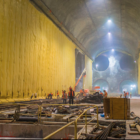Opinion
More Coastal Flooding Expected for Train Tracks — But No Plans in Place: Cameron on Transportation
|
What follows is a public apology. Not to you, dear reader, but to future generations. “To my grandchildren: I’m sorry we left you with this mess. We should have done more, when we still had time.”
What am I referring to? Not the national debt.


